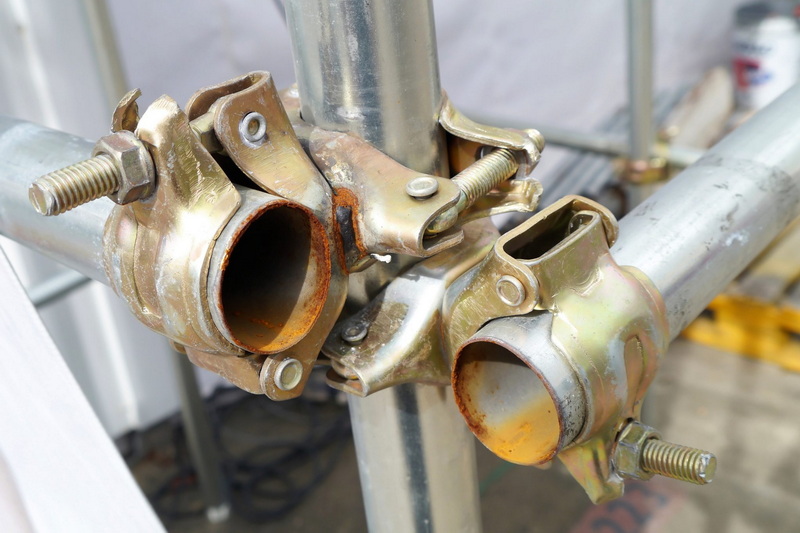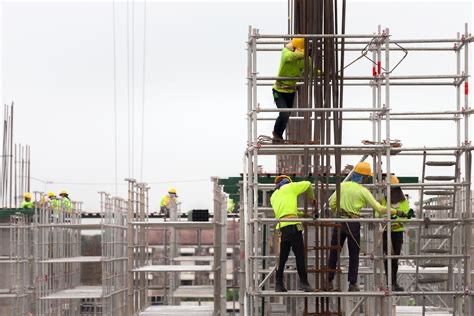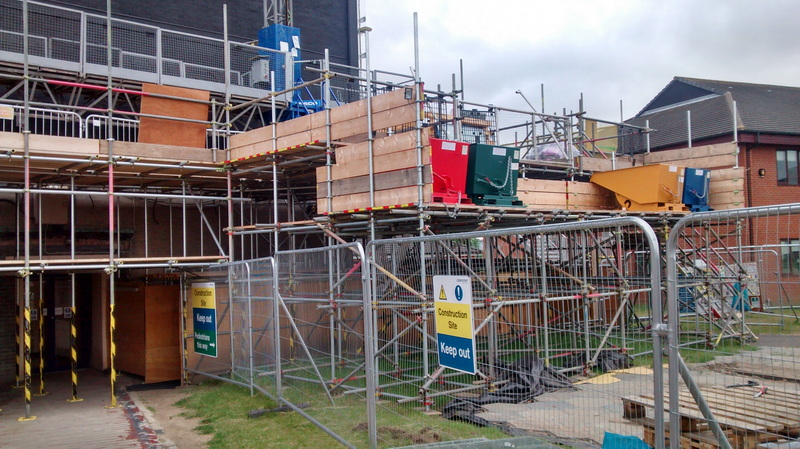Content Menu
● Introduction to Tube and Clamp Scaffolding
● Pre-Installation Preparation
● Step-by-Step Installation Guide
>> 1. Setting Up Base Plates
>> 2. Assembling Vertical Standards
>> 3. Installing Horizontal Ledgers
>> 4. Adding Transoms and Planking
>> 5. Installing Bracing and Guardrails
>> 6. Tying and Guiding
● Advanced Installation Techniques
>> 1. Cantilevered Scaffolding
>> 2. Stairway Access
>> 3. Scaffold Hoists and Lifts
● Safety Considerations
● Common Mistakes to Avoid
● Maintenance and Dismantling
● Specialized Scaffold Configurations
>> 1. Bridging Scaffolds
>> 2. Circular Scaffolds
>> 3. Mobile Scaffolds
● Training and Certification
● Conclusion
● FAQ
>> 1. What are the basic components of tube and clamp scaffolding?
>> 2. How often should scaffolding be inspected?
>> 3. What is the maximum vertical interval for installing ledgers?
>> 4. How are ties installed on scaffolds?
>> 5. What safety equipment is required for scaffold work?
● Citations:
Tube and clamp scaffolding is a versatile and widely used system in construction and maintenance projects. It consists of basic steel components such as base plates, galvanized steel tubing, and clamps. Proper installation of these components is crucial for ensuring safety and structural integrity. This article will guide you through the process of installing tube and clamp scaffolding components safely and effectively.

Introduction to Tube and Clamp Scaffolding
Tube and clamp scaffolding systems are favored for their flexibility and ease of assembly. The primary components include:
- Base Plates: These provide a stable foundation for the scaffold.
- Galvanized Steel Tubing: Available in various lengths, typically ranging from 4 to 16 feet.
- Right Angle Clamps: Used to connect tubes at right angles.
- Swivel Clamps: Allow tubes to be joined at any angle.
- Assembly Tools: Such as tube and clamp wrenches.
Pre-Installation Preparation
Before starting the installation, ensure that:
- The site is clear of debris and obstacles.
- All components are inspected for damage or wear.
- A qualified person conducts a site inspection to identify potential hazards.
- All necessary safety equipment is available and used.
Step-by-Step Installation Guide
1. Setting Up Base Plates
- Place base plates on firm, level ground to prevent the scaffold from tipping.
- Ensure base plates are securely positioned and aligned with the planned scaffold layout.
2. Assembling Vertical Standards
- Use nominal 2-inch galvanized steel tubing as vertical standards.
- Connect these standards to base plates using twist lock fittings.
- Ensure all verticals are plumb and securely fastened.
3. Installing Horizontal Ledgers
- Use right angle clamps to connect ledgers to vertical standards.
- Ensure ledgers are level and securely fastened.
- Maintain vertical intervals of no more than 6.5 feet between ledgers.
4. Adding Transoms and Planking
- Install transoms above ledgers to support scaffold planks.
- Use right angle clamps to secure transoms to ledgers.
- Lay scaffold planks across transoms, ensuring they are level and securely fastened.
5. Installing Bracing and Guardrails
- Install face bracing at approximately a 45-degree angle from the base of the outer posts.
- Add vertical bracing across the width of the scaffold at regular intervals.
- Install guardrails at least 38 inches above the deck.
6. Tying and Guiding
- Install ties to prevent the scaffold from tipping when the height exceeds four times the minimum base dimension.
- Check local regulations for stricter requirements.

Advanced Installation Techniques
1. Cantilevered Scaffolding
- Cantilevered scaffolds are used when the base cannot be placed directly under the working area.
- Ensure that cantilevered sections are properly supported and tied back to the main structure.
2. Stairway Access
- Install stairways for safe access to higher levels.
- Ensure stairways are securely attached to the scaffold and meet local building codes.
3. Scaffold Hoists and Lifts
- Use scaffold hoists or lifts to transport materials and personnel.
- Ensure all hoists are properly installed and maintained.
Safety Considerations
- Always follow local and national safety regulations.
- Use proper fall protection equipment.
- Ensure all components are securely fastened and inspected regularly.
Common Mistakes to Avoid
- Inadequate Base Preparation: Ensure base plates are on firm, level ground.
- Insufficient Bracing: Always install face and vertical bracing as required.
- Poorly Secured Components: Ensure all clamps and fittings are tightened properly.
Maintenance and Dismantling
- Regularly inspect the scaffold for wear or damage.
- Dismantle scaffolding in a controlled manner, ensuring all components are safely removed.
Specialized Scaffold Configurations
1. Bridging Scaffolds
- Used to span gaps between buildings or structures.
- Ensure bridging sections are securely tied to both sides.
2. Circular Scaffolds
- Used for projects involving cylindrical structures like tanks or chimneys.
- Ensure all components are securely fastened to maintain structural integrity.
3. Mobile Scaffolds
- Designed for easy movement around a site.
- Ensure all wheels are locked when in use and the scaffold is stable.
Training and Certification
- Ensure all personnel involved in scaffold installation are properly trained and certified.
- Regular training sessions can help maintain safety standards and compliance with regulations.
Conclusion
Proper installation of tube and clamp scaffolding components is essential for ensuring the safety and stability of the structure. By following these steps and adhering to safety guidelines, you can effectively erect a scaffold that meets your project needs.

FAQ
1. What are the basic components of tube and clamp scaffolding?
The basic components include base plates, galvanized steel tubing, right angle clamps, swivel clamps, and assembly tools.
2. How often should scaffolding be inspected?
Scaffolding should be inspected before each use and after any event that could affect its stability, such as weather conditions or alterations.
3. What is the maximum vertical interval for installing ledgers?
Ledgers should be installed at vertical intervals of no more than 6.5 feet.
4. How are ties installed on scaffolds?
Ties are installed to prevent the scaffold from tipping when the height exceeds four times the minimum base dimension. They should be connected to both standards or ledgers.
5. What safety equipment is required for scaffold work?
Proper fall protection equipment, such as harnesses and lanyards, is required for all scaffold work.
Citations:
[1] https://www.youtube.com/watch?v=ZM6Tlh_NAnQ
[2] https://www.youtube.com/watch?v=iUqDWjr6uok
[3] https://cdn.dal.ca/content/dam/dalhousie/pdf/dept/facilities/FM%20Safety/fallprotection/Safe%20Job%20Procedure%20for%20Erecting%20Tube%20and%20Clamp%20and%20All%20Around%20Scaffolding%20June%202014.pdf
[4] https://brandsafway.com/uploads/files/orn402_bsl_tube_and_clamp_safety_guidelines.pdf
[5] https://www.youtube.com/watch?v=PBOK-DmAZuo&lc=Ugg7dKA9ZXPU4ngCoAEC
[6] https://patents.google.com/patent/CN113418052A/zh
[7] https://falconladder.com/content/SCAFFOLDING/Scaffold-General-Instructions.pdf
[8] https://www.shutterstock.com/video/search/scaffolding-clamp
[9] https://patents.google.com/patent/CN101053134B/zh






















